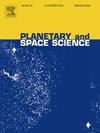Optimal choice of closest approach distance for a comet flyby: Application to the Comet Interceptor mission
IF 1.7
4区 物理与天体物理
Q3 ASTRONOMY & ASTROPHYSICS
引用次数: 0
Abstract
A comet flyby, like the one planned for the Comet Interceptor mission, takes place under conditions that remain largely unknown up to the moment of encounter. A detailed trajectory design phase, which includes verification of the technical limitations implied by the flyby geometry, precedes target comet selection. Thus the flyby velocity and the solar zenith angle at closest approach are known in advance. Solar irradiance and the neutral gas expansion speed can be estimated reasonably well. However, the comet outgassing rate, the dust production rate, and the solar wind conditions are only known within broader uncertainty margins. The present paper aims to optimally choose the one degree of freedom that is available for tuning the flyby conditions: the distance of closest approach. This choice is based on a simplified formalism that expresses, on one hand, the science return to be expected as a function of the closest approach distance, and, on the other hand, the risks implied by a close approach. This is done by performing Monte Carlo simulations over a large sample of possible comet flyby configurations, based on the expected probability distributions of the gas and dust production rates and the solar wind conditions, for different closest approach distances. For small flyby distances, a spacecraft has the opportunity to study the nucleus, the neutral gas coma, and the induced magnetosphere from up close, benefiting the science return. There is a trade-off to be made against the cometary dust collision risk, which becomes larger close to the nucleus. This trade-off is illustrated for the case of the Comet Interceptor main spacecraft and the two probes it plans to release. The change of the optimal flyby distance with gas and dust production rate, solar EUV flux, and flyby speed is discussed.

彗星飞掠最接近距离的最佳选择:在彗星拦截器任务中的应用
像彗星拦截器任务那样的彗星飞越,在遇到彗星的那一刻,在很大程度上是在未知的条件下进行的。在选择目标彗星之前,有一个详细的轨道设计阶段,包括验证飞掠几何所隐含的技术限制。这样,飞掠速度和太阳最接近的天顶角就可以提前知道了。太阳辐照度和中性气体膨胀速度可以较好地估算。然而,彗星的排气率、尘埃产生率和太阳风条件只能在更大的不确定性范围内知道。本文的目的是优化选择可用于调整飞越条件的一个自由度:最接近距离。这种选择是基于一种简化的形式,它一方面表达了科学回归作为最接近距离的函数,另一方面表达了接近方法所隐含的风险。这是通过对可能的彗星飞掠配置的大样本进行蒙特卡罗模拟来完成的,该模拟基于不同最接近距离的气体和尘埃产生率以及太阳风条件的预期概率分布。对于较小的飞掠距离,航天器有机会近距离研究彗核、中性气体彗发和感应磁层,从而有利于科学回报。在靠近彗核的地方,彗星尘埃的碰撞风险会变得更大,因此需要做出权衡。这种权衡在“彗星拦截者”主航天器和它计划发射的两个探测器的案例中得到了说明。讨论了最佳飞掠距离随气体和尘埃产生率、太阳极紫外通量和飞掠速度的变化。
本文章由计算机程序翻译,如有差异,请以英文原文为准。
求助全文
约1分钟内获得全文
求助全文
来源期刊

Planetary and Space Science
地学天文-天文与天体物理
CiteScore
5.40
自引率
4.20%
发文量
126
审稿时长
15 weeks
期刊介绍:
Planetary and Space Science publishes original articles as well as short communications (letters). Ground-based and space-borne instrumentation and laboratory simulation of solar system processes are included. The following fields of planetary and solar system research are covered:
• Celestial mechanics, including dynamical evolution of the solar system, gravitational captures and resonances, relativistic effects, tracking and dynamics
• Cosmochemistry and origin, including all aspects of the formation and initial physical and chemical evolution of the solar system
• Terrestrial planets and satellites, including the physics of the interiors, geology and morphology of the surfaces, tectonics, mineralogy and dating
• Outer planets and satellites, including formation and evolution, remote sensing at all wavelengths and in situ measurements
• Planetary atmospheres, including formation and evolution, circulation and meteorology, boundary layers, remote sensing and laboratory simulation
• Planetary magnetospheres and ionospheres, including origin of magnetic fields, magnetospheric plasma and radiation belts, and their interaction with the sun, the solar wind and satellites
• Small bodies, dust and rings, including asteroids, comets and zodiacal light and their interaction with the solar radiation and the solar wind
• Exobiology, including origin of life, detection of planetary ecosystems and pre-biological phenomena in the solar system and laboratory simulations
• Extrasolar systems, including the detection and/or the detectability of exoplanets and planetary systems, their formation and evolution, the physical and chemical properties of the exoplanets
• History of planetary and space research
 求助内容:
求助内容: 应助结果提醒方式:
应助结果提醒方式:


